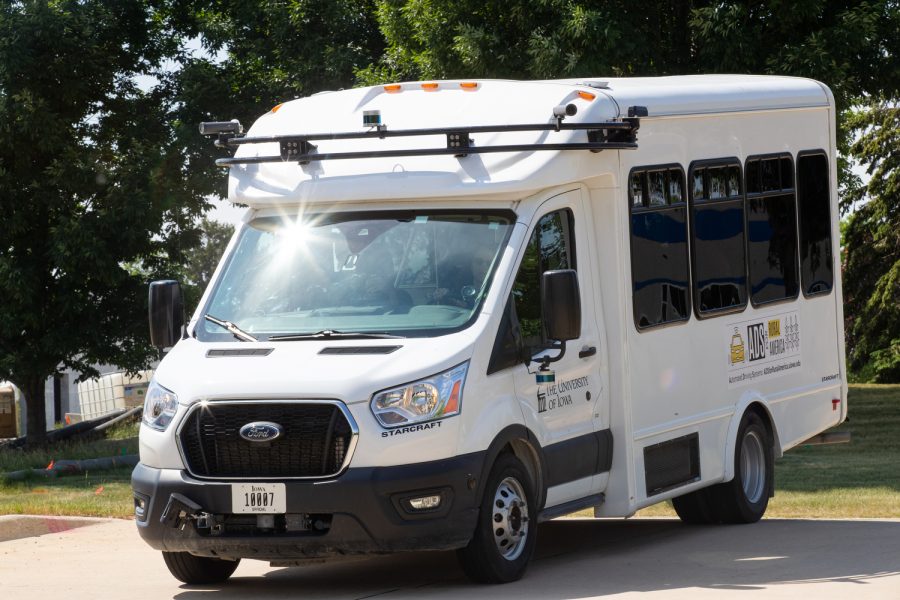UI Driving Safety Research Institute unveils autonomous vehicle designed for rural roads
In an event on June 13, institute researchers showed off an autonomous van designed to drive on rural roads, and highlighted the technologies future potential.
The Automated Driving Systems for Rural America presented its two-and-a-half-year research project on Tuesday, June 13, 2023. The vehicle has light detection and ranging camera, computer vision systems, and RADARs to detect its surroundings. It also includes a safety driver at all times. Professor Daniel V. McGehee, Director of the Driving Safety Research Institute, explained that this would be the first time this kind of data will be looked at globally and used as a building block for the next generation.
June 13, 2023
On Tuesday morning, a dozen journalists gathered at the University of Iowa Driving Safety Research Institute, also known as the National Advanced Driving Simulator, facility.
The institute held an event for members of the press to view and take a ride in an autonomous vehicle developed for the recently completed Automated Driving Systems for Rural America project.
According to a handout given at the event, the project was created to see if autonomous vehicles could be a viable option for elderly or disabled individuals living in rural areas. This would be another option for residents in those areas who lack many options besides things like Johnson County’s SEATS service.
In a speech during the event, Automated Driving Systems for Rural America project manager Omar Ahmad emphasized the goals of the project.
“The main goals of this project are to look at how automated vehicle technologies can function on rural roadways. And the reason why this is very important is because half of all traffic fatalities occur on rural roadways,” Ahmad said. “If automated vehicles are going to realize their potential for improving safety, then we want them to do it on all different types of roadways, including rural roadways.”
He said that during testing, the vehicle could drive on its own 99 percent of the time, taking a 47-mile route going from Iowa City to Hills, Riverside, and Kelowna. The vehicle was also capable of driving at any time of day, including night, and had been used through different seasons in Iowa.
Also at the event was Dan McGehee, director of the institute. In an interview with The Daily Iowan, he said the U.S. Department of Transportation had funded the project, and that it is one of the first projects to tackle autonomous driving on rural roads.
RELATED: Johnson County launches new on-demand ride service for those with transportation barriers
“When you read about companies in Silicon Valley, and Arizona and Florida, those are done in states that have 12 months of sunshine and really clean roads, black top, white, and pink, yellow paint, [and] that is very clear to computer vision systems,” McGehee said. “When you come to rural America, those paint lines are not very clear if they exist at all, and we drive on gravel a lot in rural America. So this project really put together the first prototype vehicle to be able to operate rural roads.”
McGehee also highlighted during a speech at the event that the vehicle being used in the project wasn’t a Tesla or another high-end car with self-driving capabilities, but a van.
“It’s a very normal transit van that’s designed to pick up rural Iowans. We have a handicap lift in this vehicle, so this is a very functional project where Iowans first get access to the [highest] technology that we have to offer not only in Iowa, but in the U.S. and in the world,” he said.
At one point during the event, the DI was allowed to ride in the vehicle for a one-mile trip around the area. The van drove cautiously during the trip, never going above the speed limit and always stopping at intersections and railroad tracks before continuing.
It completed the trip with ease, a testament to the technology behind its function. McGehee explained that the van was equipped with cameras and several types of sensors, including radar and a technology called light detection and ranging, or LiDAR.
As for the future of the technology, McGehee said implementation for the public is still far off.
“This is really a first step, and in getting this to work, despite what you might read in the media that seems like things are here tomorrow, it’s going to be a very, very long time, decades. Before you see a lot of these vehicles, you’ll see a number of these demonstration projects. But implementation is quite different,” he said.
This is something echoed by Ahmad, although he also highlighted the potential for the technology.
“There’s so much potential there to make driving safer for everybody and to help people get from one point to another. But we are partly at a stage where the technologies need to be tested, and they need close supervision by a trained human driver,” Ahmad said. “There’s a lot of work that still needs to be done, [but] we’re really happy and proud to be part of part of this entire process.”



